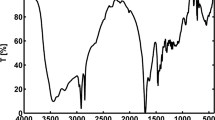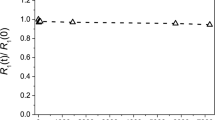Abstract
The one-pot synthesis of iron-doped carbon quantum dots (Fe-CQDs) for use as both magnetic resonance (MR) and fluorescent (dual-mode) imaging nanoprobes is described. Comprehensive characterizations of the material confirmed the successful doping of the CQDs with Fe(II) ions. The imaging probe has a longitudinal relaxivity of 3.92 mM−1∙s−1 and a low r2/r1 ratio of 1.27, both of which are critical for T1-weighted contrast agents. The maximum emission of Fe-CQDs locates at 450 nm under 375 nm excitation, which also can be applied to fluorescence imaging. Biotoxicity assessment showed good biocompatibility of the Fe-CQDs. The in-vitro experiments with A549 cells indicated that the Fe-CQDs are viable candidates as dual-mode (MR/fluorescence) imaging nanoprobes. For in-vivo experiments, they exhibit high contrast efficiency, thereby improving the positive contrast in T1-weighted MR images. In-vivo time-dependent MRI of major organs showed that the Fe-CQDs undergo fast glomerular filtration and can evade immuno-absorption due to their ultra-small size and excellent biocompatibility.

Schematic presentation of the synthesis of Fe-CQDs and applications to magnetic resonance and fluorescent dual-mode imaging.







Similar content being viewed by others
References
Na HB, Song IC, Hyeon T (2009) Inorganic nanoparticles for MRI contrast agents. Adv Mater 21:2133–2148
Jang JT, Nah H, Lee JH, Moon SH, Kim MG, Cheon J (2009) Critical enhancements of MRI contrast and hyperthermic effects by dopant-controlled magnetic nanoparticles. Angew Chem Int Ed 48:1234–1238
Kim BH, Lee N, Kim H, An K, Park YI, Choi Y, Shin K, Lee Y, Kwon SG, Na HB, Park JG, Ahn TY, Kim YW, Moon WK, Choi SH, Hyeon T (2011) Large-scale synthesis of uniform and extremely small-sized iron oxide nanoparticles for high-resolution T1 magnetic resonance imaging contrast agents. J Am Chem Soc 133:12624–12631
Rieter WJ, Kim JS, Taylor KML, An H, Lin W, Tarrant T, Lin W (2007) Hybrid silica nanoparticles for multimodal imaging. Angew Chem Int Ed 46:3680–3682
Boros E, Polasek M, Zhang Z, Caravan P (2012) Gd (DOTAla): a single amino acid Gd-complex as a modular tool for high relaxivity MR contrast agent development. J Am Chem Soc 134:19858–19868
Bridot JL, Faure AC, Laurent S, Riviere C, Billotey C, Hiba B, Janier M, Josserand V, Coll JL, Elst LV, Muller R, Roux S, Perriat P, Tillement O (2007) Hybrid gadolinium oxide nanoparticles: multimodal contrast agents for in vivo imaging. J Am Chem Soc 129:5076–5084
Blasco Perrin H, Glaser B, Pienkowski M, Peron JM, Payen JL (2013) Gadolinium induced recurrent acute pancreatitis. Pancreatology 13:88–89
Akgun H, Gonlusen G, Cartwright JJ, Suki WN, Truong LD (2006) Are gadolinium-based contrast media nephrotoxic? A renal biopsy study. Arch Pathol Lab Med 130:1354–1357
Hui FK, Mullins M (2009) Persistence of gadolinium contrast enhancement in CSF: a possible harbinger of gadolinium neurotoxicity? AJNR Am J Neuroradiol 30:E1
Muldoon LL, Neuwelt EA (2015) Dose-dependent neurotoxicity (seizures) due to deposition of gadolinium-based contrast agents in the central nervous system. Radiology 277:925–926
Penfield JG, Reilly Jr RF (2007) What nephrologists need to know about gadolinium. Nat Clin Pract Nephrol 3: 654–668
Branch SM, Tweedle MF, Orton CG (2017) The use of gadolinium-based contrast agents should be discontinued until proven safe. Med Phys 44:3371–3374
Yao YY, Gedda G, Girma WM, Yen CL, Ling YC, Chang JY (2017) Magnetofluorescent carbon dots derived from crab shell for targeted dual-modality bioimaging and drug delivery. ACS Appl Mater Interfaces 9:13887–13899
Chen R, Ling D, Zhao L, Wang S, Liu Y, Bai R, Baik S, Zhao Y, Chen C, Hyeon T (2015) Parallel comparative studies on mouse toxicity of oxide nanoparticle- and gadolinium-based T1 MRI contrast agents. ACS Nano 9:12425–12435
Lu CY, Ji JS, Zhu XL, Tang PF, Zhang Q, Zhang NN, Wang ZH, Wang XJ, Chen WQ, Hu JB, Du YZ, Yu RS (2017) T2-weighted magnetic resonance imaging of hepatic tumor guided by SPIO-loaded nanostructured lipid carriers and ferritin reporter genes. ACS Appl Mater Interfaces 9:35548–35561
Wang S, Yang W, Du H, Guo F, Wang H, Chang J, Gong X, Zhang B (2016) Multifunctional reduction-responsive SPIO&DOX-loaded PEGylated polymeric lipid vesicles for magnetic resonance imaging-guided drug delivery. Nanotechnology 27:165101
Lee N, Kim H, Choi SH, Park M, Kim D, Kim HC, Choi Y, Lin S, Kim BH, Jung HS, Kim H, Park KS, Moon WK, Hyeon T (2011) Magnetosome-like ferrimagnetic iron oxide nanocubes for highly sensitive MRI of single cells and transplanted pancreatic islets. Proc Natl Acad Sci U S A 108:2662–2667
Rub Pakkath SA, Chetty SS, Selvarasu P, Vadivel Murugan A, Kumar Y, Periyasamy L, Santhakumar M, Sadras SR, Santhakumar K (2018) Transition metal ion (Mn2+, Fe2+, Co2+, and Ni2+)-doped carbon dots synthesized via microwave-assisted pyrolysis: a potential nanoprobe for magneto-fluorescent dual-modality bioimaging. ACS Biomater Sci Eng 4:2582–2596
Hao D, Ai T, Goerner F, Hu X, Runge VM, Tweedle M (2012) MRI contrast agents: basic chemistry and safety. J Magn Reson Imaging 36:1060–1071
Kunjachan S, Ehling J, Storm G, Kiessling F, Lammers T (2015) Noninvasive imaging of nanomedicines and nanotheranostics: principles, progress, and prospects. Chem Rev 115:10907–10937
Pan Y, Chen WD, Yang J, Zheng JH, Yang MS, Yi CQ (2018) Facile synthesis of gadolinium chelate-conjugated polymer nanoparticles for fluorescence/magnetic resonance dual-modal imaging. Anal Chem 90:1992–2000
Omer KM, Tofiq DI, Hassan AQ (2018) Solvothermal synthesis of phosphorus and nitrogen doped carbon quantum dots as a fluorescent probe for iron(III). Microchim Acta 185:466
Gui WY, Zhang JR, Chen XQ, Yu DH, Ma Q (2017) N-doped graphene quantum dot@mesoporous silica nanoparticles modified with hyaluronic acid for fluorescent imaging of tumor cells and drug delivery. Microchim Acta 185:66
Shi YP, Pan Y, Zhong J, Yang J, Zheng JH, Cheng JL, Song R, Yi CQ (2015) Facile synthesis of gadolinium (III) chelates functionalized carbon quantum dots for fluorescence and magnetic resonance dual-modal bioimaging. Carbon 93:742–750
Chiu SH, Gedda G, Girma WM, Chen JK, Ling YC, Ghule AV, Ou KL, Chang JY (2016) Rapid fabrication of carbon quantum dots as multifunctional nanovehicles for dual-modal targeted imaging and chemotherapy. Acta Biomater 46:151–164
Wang WP, Lu YC, Huang H, Wang AJ, Chen JR, Feng JJ (2014) Solvent-free synthesis of sulfur-and nitrogen-co-doped fluorescent carbon nanoparticles from glutathione for highly selective and sensitive detection of mercury(II) ions. Sensor Actuat B-Chem 202:741–747
Xu Y, Jia XH, Yin XB, He XW, Zhang YK (2014) Carbon quantum dot stabilized gadolinium nanoprobe prepared via a one-pot hydrothermal approach for magnetic resonance and fluorescence dual-modality bioimaging. Anal Chem 86:12122–12129
Ren X, Liu J, Ren J, Tang F, Meng X (2015) One-pot synthesis of active copper-containing carbon dots with laccase-like activities. Nanoscale 7:19641–19646
Ma M, Zhang Y, Guo Z, Gu N (2013) Facile synthesis of ultrathin magnetic iron oxide nanoplates by Schikorr reaction. Nanoscale Res Lett 8:16
Su XQ, Chan CY, Shi JY, Tsang MK, Pan Y, Cheng CM, Gerile OD, Yang M (2017) A graphene quantum dot@Fe3O4@SiO2 based nanoprobe for drug delivery sensing and dual-modal fluorescence and MRI imaging in cancer cells. Biosens Bioelectron 92:489–495
Jun YW, Lee JH, Cheon J (2008) Chemical design of nanoparticle probes for high-performance magnetic resonance imaging. Angew Chem Int Ed 47:5122–5135
Liu CL, Peng YK, Chou SW, Tseng WH, Tseng YJ, Chen HC, Hsiao JK, Chou PT (2014) One-step, room-temperature synthesis of glutathione-capped iron-oxide nanoparticles and their application in in vivo T1-weighted magnetic resonance imaging. Small 10:3962–3969
Zhao HX, Liu LQ, Liu ZD, Wang Y, Zhao XJ, Huang CZ (2011) Highly selective detection of phosphate in very complicated matrixes with an off-on fluorescent probe of europium-adjusted carbon dots. Chem Commun 47:2604–2606
Bai JM, Zhang L, Liang RP, Qiu JD (2013) Graphene quantum dots combined with europium ions as photoluminescent probes for phosphate sensing. Chem Eur J 19:3822–3826
Chen L, Chen J, Qiu S, Wen L, Wu Y, Hou Y, Wang Y, Zeng J, Feng Y, Li Z, Shan H, Gao M (2018) Biodegradable nanoagents with short biological half-life for SPECT/PAI/MRI multimodality imaging and PTT therapy of tumors. Small 14:1702700
Acknowledgements
This work was financially supported by the National Natural Science Foundation of China (NSFC, No. 21405174) and The Science and Technology Innovation Program of Social Undertakings and People’s Livelihood Security of Chongqing Science and Technology Commission (cstc2016shms-ztzx10002).
Author information
Authors and Affiliations
Corresponding authors
Ethics declarations
The author(s) declare that they have no competing interests.
Additional information
Publisher’s note
Springer Nature remains neutral with regard to jurisdictional claims in published maps and institutional affiliations.
Electronic supplementary material
ESM 1
(DOCX 3.52 mb)
Rights and permissions
About this article
Cite this article
Huang, Q., Liu, Y., Zheng, L. et al. Biocompatible iron(II)-doped carbon dots as T1-weighted magnetic resonance contrast agents and fluorescence imaging probes. Microchim Acta 186, 492 (2019). https://doi.org/10.1007/s00604-019-3593-4
Received:
Accepted:
Published:
DOI: https://doi.org/10.1007/s00604-019-3593-4




